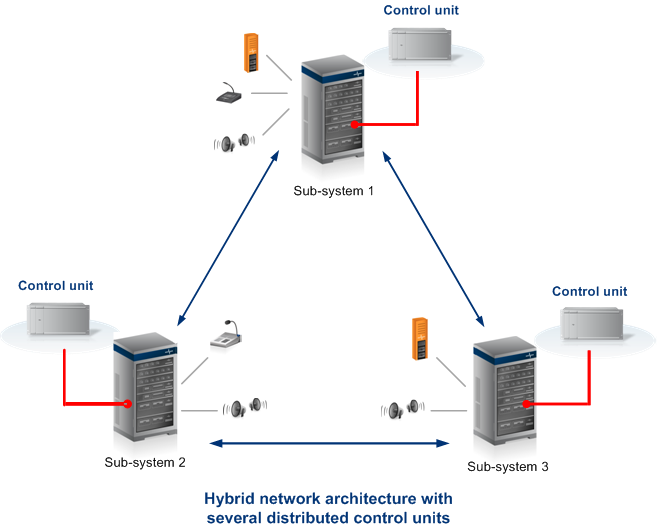A post by our colleague Roland Leuthe, Head of Development “Systems Software”
In one of our previous blog posts (“Centralized vs. Decentralized System Architecture”) we mentioned that complex functions or the connection of external interfaces cannot reliably be implemented when using a completely decentralized system architecture.
However, the major drawback of one centralized control unit is that a failure of said component leads to a complete failure of the entire system. Of course, for systems with high safety requirements such as PA/GA systems the central control unit is typically installed redundantly to increase system reliability. In case the main control unit fails, the redundant unit ensures the proper operation of the system.
Though a redundant configuration provides increased protection in case of failure it is not recommended for large systems to connect all terminals and external interfaces to one single control unit.
A more sophisticated solution would be a hybrid system architecture. This means that the overall function of a system is distributed to several, locally separated communication nodes. Each node is responsible for one sub-area of the overall system and controls all components and terminals of this specific area. All communication nodes of the overall system can be composed of a flat or hierarchical structure.
A reasonable way here is to define individual communication nodes so that they form logical sub-systems in terms of functions. This means if one communication node fails, all local functions of the other sub-systems are still available without restrictions. If your own sub-system fails, only local or referenced functions which are controlled by your own sub-system will no longer work. To reduce the risk that a single node fails, the nodes should of course be redundant.
The individual communication nodes can communicate via suitable control protocols so that complex functions can reliably be implemented into large systems using this hybrid architecture. Furthermore, external interfaces can be connected to different nodes: e.g. to the nearest or to the most suitable node in terms of functionality. In addition, a hybrid architecture provides scalability, from small through to the largest systems.
The INTRON-D plus system provides exactly this hybrid system architecture. It combines the advantages of a centralized with those of a decentralized architecture without having the respective disadvantages mentioned above. One major advantage of using a hybrid system architecture is that single points of failure can be avoided.

